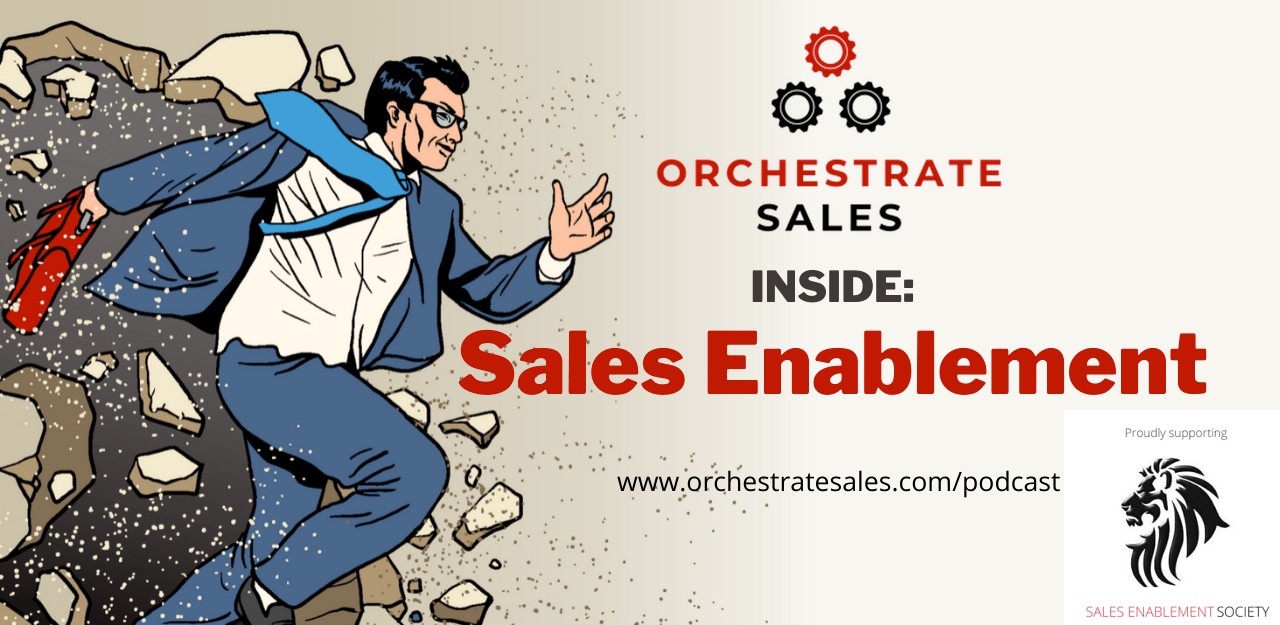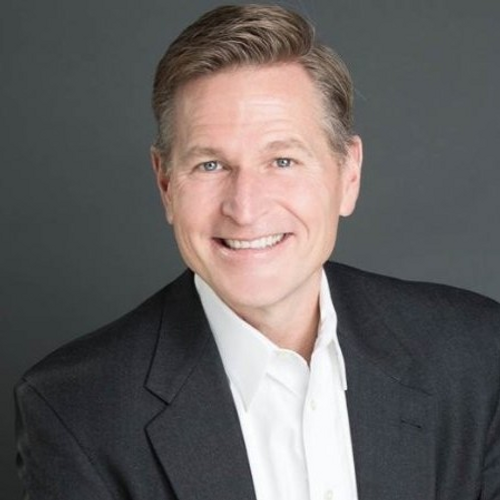Ep23 Who Is the Customer of Sales Enablement & the Ford Edsel
Welcome to the Inside Sales Enablement Podcast, Episode 23
Sales enablement leaders work at the intersection of sales leadership, marketing, product, and operations to help engineer and elevate sales conversations.
As Sales Enablement pros work across these stakeholder groups they often experience very high expectations, leading to challenges and friction if not handled well.
If you are a sales enablement professional, you know there are a lot of people to serve. You also know that they aren't all your customers, and you can't treat everyone who wants something the same. So, the question is, how do you parse people out? Who do you listen to?
Join us at https://www.OrchestrateSales.com/podcast/ to collaborate with peers, join Insider Nation, participate in the conversation and be part of the continued elevation of the profession.
EPISODE TRANSCRIPT:
Nick Merinkers 00:02
Welcome to the inside sales enablement podcast. Where has the profession been? Where is it now? And where is it heading? What does it mean to you, your company, other functions? The market? Find out here. Join the founding father of the sales enablement profession Scott Santucci and Trailblazer Brian Lambert as they take you behind the scenes of the birth of an industry, the inside sales enablement podcast starts now.
Scott Santucci 00:34
I'm Scott Santucci.
Brian Lambert 00:36
Brian Lambert and we are the sales enablement insiders. Our podcast for sales enablement, leaders looking to elevate their function, expand their sphere of influence, and increase the span of control within their companies.
Scott Santucci 00:49
Together Brian, I've worked in over 100 different kinds of sales enablement initiatives as analyst, consultants, or practitioners. We've learned the hard way what works and maybe more importantly, what doesn't.
Brian Lambert 01:03
That's right, Scott. And today on this show, what we're going to discuss everybody is, who is the customer of sales enablement? That's right. It's a kind of a Zen question, but who is our customer? And as usual, we're going to start with a centering story. Give our episode of scene. So, Scott, what do you have for us?
Scott Santucci 01:22
Well, I feel like I'm going in a way, way, way forward machine here with a story that starts in 1958, not 1858, if you've been listening to our our show. In 1958, the executives at Ford got pretty much religion on this, this new thing about market research. So, if you've been following maybe watch madman and you realize that, you know, the advertising industry was really starting to evolve in the late 50s and early 60s, and that's actually a true thing. And they started doing market research. And the executives at Ford got this great idea. What if we did market research to design a car? Makes sense, right? So, they surveyed lots of users or lots of cuts or users, that's a modern term, lots of customers about what they want to see in a car. And they design this car based on this feedback of all these people, they're going to get massive market share because they made sure that they got every type of person involved from older people, people with families, single single people, people want to have people who wanted to, you know, a family environment, took all that information. And they designed a car for everybody. And they roll it out expecting marriage is going to clean house and dominate market share. You know what the name of that product was?
Brian Lambert 02:57
Was it the Edsel?
Scott Santucci 02:59
It was the Edsel yeah, and the Edsel claim by 1960. By 1960 they pulled it from the shelf. So, it's just a two-year life cycle, which is not a long time for any kind of car. And they invested so much money that in 1960, they reported a loss of $250 million on that initiative. $250 million. That's a lot of money isn't it, Brian.
Brian Lambert 03:29
Well, I'm sure in 1960, it was.
Scott Santucci 03:32
Well, it made a lot of money for today, I mean, losing $250 million. No one's gonna write that one, write that in a statement. That's what they'll give you. Let's put it in the frame. Let's frame it out, though. In if that were today, the scope of that failure would have been $2.2 billion dollars, without the headlines that would have on msnbc or what we'd be here to talk about the huge catastrophic failure before?
Brian Lambert 04:02
Hmm. Well, gee, that's, that's interesting because they did the research and they probably saw the huge market opportunity, built the car that hit all the customer feedback and had a colossal failure. So that's interesting. And what do you what do you think? What what why that story with regard to who is our customer?
Scott Santucci 04:28
Yeah, so what is so white right? What does that have to do with anything? The reason it has anything to do with why we're talking about it and the theme for today sales enablement? Who is your customer? is because when Ford the Ford executives designed the Edsel for everybody, they actually made it for nobody. And that's really what we're finding a lot of is a lot of people. There's a bunch of definitions about what sales enablement is or isn't. There's a lot of terminology that people keep debating at the end of the day, if you're not really clear on who your customers are, and servicing, it doesn't really matter.
Brian Lambert 05:11
Yeah. So, let me let me pop quiz are our nation, insider nation? Pop quiz. I'll give you three seconds to answer this question, Who who's the customer of sales enablement? Let's answer that question Who is the customer sales enablement? And I'm willing to guess if you're like most people, you're probably saying sales, or you're running down a huge list of people that you talk to or work with. So, you know, Scott, what do you think is that the right way to think about it is the first group that comes to mind are the people you're working with on a day-to-day basis?
Scott Santucci 05:51
Right, so the words the functions called sales enablement, of course sales is our customer, right?
Brian Lambert 05:57
That's right
Scott Santucci 06:00
I would beg to differ. Your customer is the person who gives you money.
Brian Lambert 06:05
Period. Yeah, you're a second. So, okay, so are you so a customer in business is somebody who definitely gives you money, I'll give you that. Take your wallet out by your ice cream, you're a customer of that ice cream place. Um, in this case and sales enablement, you're saying the same thing literally, that's not that's not a analog. That's a, that's a literal statement.
Scott Santucci 06:31
Your customer is the the person who's who's the department or whoever is giving who's funding your department or funding you if you're a one man show. If you're a one-man band, your customer is whoever's paying your check. Who you serve, may be salespeople. But a salesperson isn't going to write you a check. They're not your customers. Your customer is the person who's giving you the check. So, you have two variables here you have what your customer wants. And then you have the way that you're going to give them what they want. You service, the Salesforce. So right there you have you might have, you might be at odds with different people. And it's important to think about why my customer is the person who's giving me the money, who I serve is people in Salesforce.
Brian Lambert 07:30
Yeah. So, this is good. So, let's, let's, let's kind of pull this out. Right. So, you've got two buckets. And let's just say the whole entire group is, you know, people, and we broke the people into two groups. One is our customer, and that's who gives us the money. And I think that would be good to understand that because sometimes that money is centralized, and you just given a budget. So, we were probably let's, let's make sure we talked about how do we know who that customer is and then the second bucket I'll just call it stakeholders, you know, CFC stakeholders and customers. And the stakeholder bucket is the folks that we work with marketing, product sales, salespeople, our stakeholders, even, you know, the impacted groups. And I think there's a lot of impacted groups, it puts us in sales enablement. In a rock between a rock and a hard place. Basically, you have all these, you know, competing inputs, different priorities, different asks from from both groups, stakeholders and customers. And I, I can see where you're going with this. Because if you lose sight of who's in what bucket, you may take different types of action. And then sometimes, and I've seen this, in the folks that I've talked to, sometimes the squeaky wheel gets the most service because they're the loudest, is that really want to be serving is the person who's got the loudest opinion?
Scott Santucci 08:52
Does that put you in a spot or where you add the most value?
Brian Lambert 08:55
That's right. That's right. So, what do you think about that cost? buckets. stakeholder bucket?
Scott Santucci 09:02
Yeah, let's go yeah, let's go through some scenarios. There are, I think we identified three or four classic places where a sales enablement department can report into. Yeah. And let's, let's talk through, like, if you report into who you report into is your customer.
Brian Lambert 09:25
Okay, okay. Yeah, so what about, let's say, marketing, if you report into marketing, that senior VP CMOS, your customer, that who would be the people we serve are the stakeholders that we're working with?
Scott Santucci 09:44
Right, so if if you are reporting to the CMO, and you're the head of sales enablement, why do you report there? What is it that he or she wants? He or she wants to be able to improve how the company is delivering messages through the sales channel to be able to be differentiated. So, who do you serve? You serve one, the people who have messaging inside the marketing department to make it more sales accessible. That's one person you serve. You may even serve the product people to make it more translate translatable. You might be serving product launches and how to get the word out to sales. You also are servicing salespeople. Since your remit in that area probably won't include training. So, you are servicing information about your products and services and about differentiation. So, you are servicing salespeople by helping them with the information required for a launch where the information to differentiate or some some messaging that's who you're servicing and how you're servicing them.
Brian Lambert 11:04
So, if I'm a sales leader, and I come to you and your reporting in the marketing, I say, you know, hey, you should really take over that sales kickoff, you know, you're better at it. What would be your answer?
Scott Santucci 11:17
Well, I would say, are you going to give us funding for that?
Brian Lambert 11:22
Right, because it's out of your scope. Right now.
Scott Santucci 11:24
It well, it's, it's that is not a service that my customer is offering that's outside of the marketing span of control. So, I'd say let's go talk to our boss. So, I would go talk to my boss, the CMO. And I'd say, look, this is a great opportunity it's a great platform for us to provide a foundation to deliver lots of messages, we should do this. And they would say that makes a lot of sense that's great because it's part of your mission. You're right. It does give us a better platform. We should do it. Then we got we negotiate and say what do we want for in exchange? So, what are you going to give us? Are you going to give us the budget for it because we're not going to pay for the whole budget for it? You You already have a budget for sales kickoffs. So, let's use your budget, let's use your resources.
Brian Lambert 12:18
Right. So, send us the money plus two people or whatever. Yeah, right.
Scott Santucci 12:22
Yeah. And we'll, we'll happily do it.
Brian Lambert 12:25
Okay, let's go to the next one.
Scott Santucci 12:26
Yep.
Brian Lambert 12:28
Let's see a sales op. So, if I'm reporting it Ops, I'm a sales leader, a sales enablement leader reporting to ops and I'm probably, you know, working on the kickoff or sales process work, maybe even, you know, forecasting, pipeline reporting, stuff like that.
Scott Santucci 12:48
Okay, so these are again, each of these scenarios by the way, a disclaimer, each of these scenarios are going to be different. We need to make sure you're clear on what it is that each each one of your customers want. But let's, let's say a classic VP of or head of sales operations, if you're reporting there, they're probably looking at a bunch of functional capabilities that they need to have they need to possess. So, for example, it is very common that a sales Operations Group is going to look at the functionality of the sales force and what the capabilities are, whether we have the right skills and the right talent to be able to execute the sales model. Okay, so what they'll say is, you know, what, we need a talent pillar or talent component of that. We call that sales enablement. And I expect you as the sale, they probably won't say that. They'll just describe, you know, you know, what we're looking for, but this is what your job is to do is to make sure it's clear what's expected of you. What is the service, what does the customer want, but really what what they're looking for is probably adoption of the sales methodology that they've that they've worked on with the VP of sales. So, who am I servicing, I am servicing the I am servicing the sales managers and the sales leadership on first educating them on that sales methodology, how it works, how they can, how they can make it work, and then providing training for that? I might also own very specific tasks, like new hire training, but maybe even managing kickoffs, and we talked about the sales kickoff before I might manage those. So, I could I am servicing the sales force through that lens.
Brian Lambert 14:46
Yeah, and all that is to be to be determined discussions would happen then obviously, that would get documented in the charter and socialized so everybody understands. who your customer is of sales enablement? And then to who you're servicing and who you're working with and the stakeholders impacted, including dependencies, I would say like, what are you dependent upon? What do you need from people to pull off your, your services? And what's that working relationship?
Scott Santucci 15:19
And let me reiterate why this is so important. why it's so important is because let's take the sales kickoff, for example. If you are in this role in your report in a sales operation, you're going to feel obligated to make sure that all the content, all the kickoff stuff is all organized, all well done, etc. So, you're going to take on a lot more extra work. If you say my job is managing the kickoffs, and you can delineate roles and responsibilities and say, Hey, marketing, you need to get us this material a week before and it needs to be in this format, and we're going to roleplay how we present it then you spend less work and you're putting the work on to the people who are plugging into it. Obviously, you can't say that to your CEO who's going to show up at the last moment, you know, with their content. But that's how you manage that by saying this is what my remit is, and this is what my focus is, and my focus is on the head of sales operations.
Brian Lambert 16:20
Cause they're my primary customer.
Scott Santucci 16:22
They are they are my customer period. Yeah. Now, you'd have to be conscious about who their customers are. Right? Those are yours, they're secondary, so you know how your services fitting into an overall plan. But especially if you talk to stakeholders that are outside of your, you know, daily remit, they're going to want to know how it all fits together, so you should be aware of it. But it's just this intentionality and focus is really important in terms of establishing roles and responsibilities and more importantly, your workload, the quality of work that you provide, and the resources that you get
Brian Lambert 17:00
So where does the VP of Sales fit in these scenarios? If you're working under marketing and Ops, and those are your customers, what's the what's the role of the VP of sales, then the sales leadership?
Scott Santucci 17:13
Well, then the VPS in terms of the CMO, the CMO is the one who should pair up with a relationship with this VP of sales. I might be an account, we might work it out to where I clear the account manager role, you know, a liaison, but I should always have meetings with both of those together. Always. And sort of facilitate it is not my responsibility to build the relationship there. It's my responsibility to help the VP of Sales beat VP of Marketing have a better relationship there. My job is to make my customer, the hero. If the VP of Marketing is going engaged with the sales leaders, then that's what needs to be done. If he or she does doesn't want to work with it with the sales leaders, we didn't make that clear. It's our job to make sure that our customers are successful. So that means we might say we you need to participate, let me get you prepared let me give you you know, some of that feedback. You don't want to be in unnatural spots. Same thing with a with a with the head of sales operations. Here's the feedback that I'm going to give you. Let's rehearse beforehand what our messaging is. How are we going to tackle it? What's my role? What's your role?
Brian Lambert 18:30
Yeah. So that VP of sales is then what is that a the the beneficiary of the work that you're doing as a stakeholder it's not it's not a customer. Because you're if you're the CMO is the customer is the VP of sales, you're the benefit beneficiary.
Scott Santucci 18:48
I am in service of right so the value that the VP of Sales gets from New Hire training. He's a that's the benefit that he gets out of it. Everybody in our organization gets the benefit of the new hire training that I'm doing, say and if I'm reporting to have a sales op, sales ops, the customer is likely the VP of sales. So, we got a different, a different, a different situation to sort out, though I am responsible for providing capabilities that my boss, the VP of operations provides back. Gotcha. It's important, you know, you know that, so you don't start thinking that you're like, the king of everything, and then you get out of alignment with your with your boss. It's not good.
Brian Lambert 19:39
Right so what
Scott Santucci 19:42
What's another scenario,...




